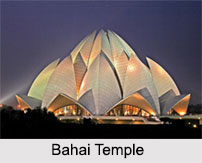 Bahai Temple is one of attractions of New Delhi. It is the most visited monuments in India. Construction of Bahai temple is completed in the year 1986. The Bahai Temple is free to all, in spite of religion or any other requirements. The building is composed of 27 free-standing marble-clad "petals" fixed in clusters of three to form nine sides, with nine doors opening onto a central hall with height of a little over 40 metres. It has won several architectural awards and been featured in hundreds of newspaper and magazine.
Bahai Temple is one of attractions of New Delhi. It is the most visited monuments in India. Construction of Bahai temple is completed in the year 1986. The Bahai Temple is free to all, in spite of religion or any other requirements. The building is composed of 27 free-standing marble-clad "petals" fixed in clusters of three to form nine sides, with nine doors opening onto a central hall with height of a little over 40 metres. It has won several architectural awards and been featured in hundreds of newspaper and magazine.
Narration of Bahai Temple
Many people say that Bahai Temple looks like a lotus in shape and because of it; this is well-known as Lotus Temple. Lotus is a representation of love and limpidness. It is one of the extraordinary architectures of Bahai devotion. The Bahai temple was completed in 1986. Since then the temple has received appreciation from all over the world for its wonderful architecture and intend. The recognition for building this stunning construction goes to the Iranian-American architect Fariborz Sahba. There is a profound and universal admiration for lotus, which is considered as a holy flower associated with adoration all through many centuries. The history of the Bahai  Faith in India started with the beginning of the Faith in Iran when the "BÂib" (accurately, the Gate) inaugurated a new period in the history of the human race.
Construction of Bahai Temple
The construction of Bahai Temple took almost 10 years before it got shape and was open for public. The team included 800 engineers, technicians, workers and artisans who worked industriously to provide recognition to one of the most multifaceted constructions in the world. The temple incorporates artistic values along with the technological influence within the whole construction. The region on which the temple is constructed was bought from the money donated by Ardishir Rustampur of Hyderabad. He gave away all his life-savings in 1953 for the temple to be constructed. A firm named Flint and Neil was given the structural design project while the construction project was undertaken by ECC Construction Group.











